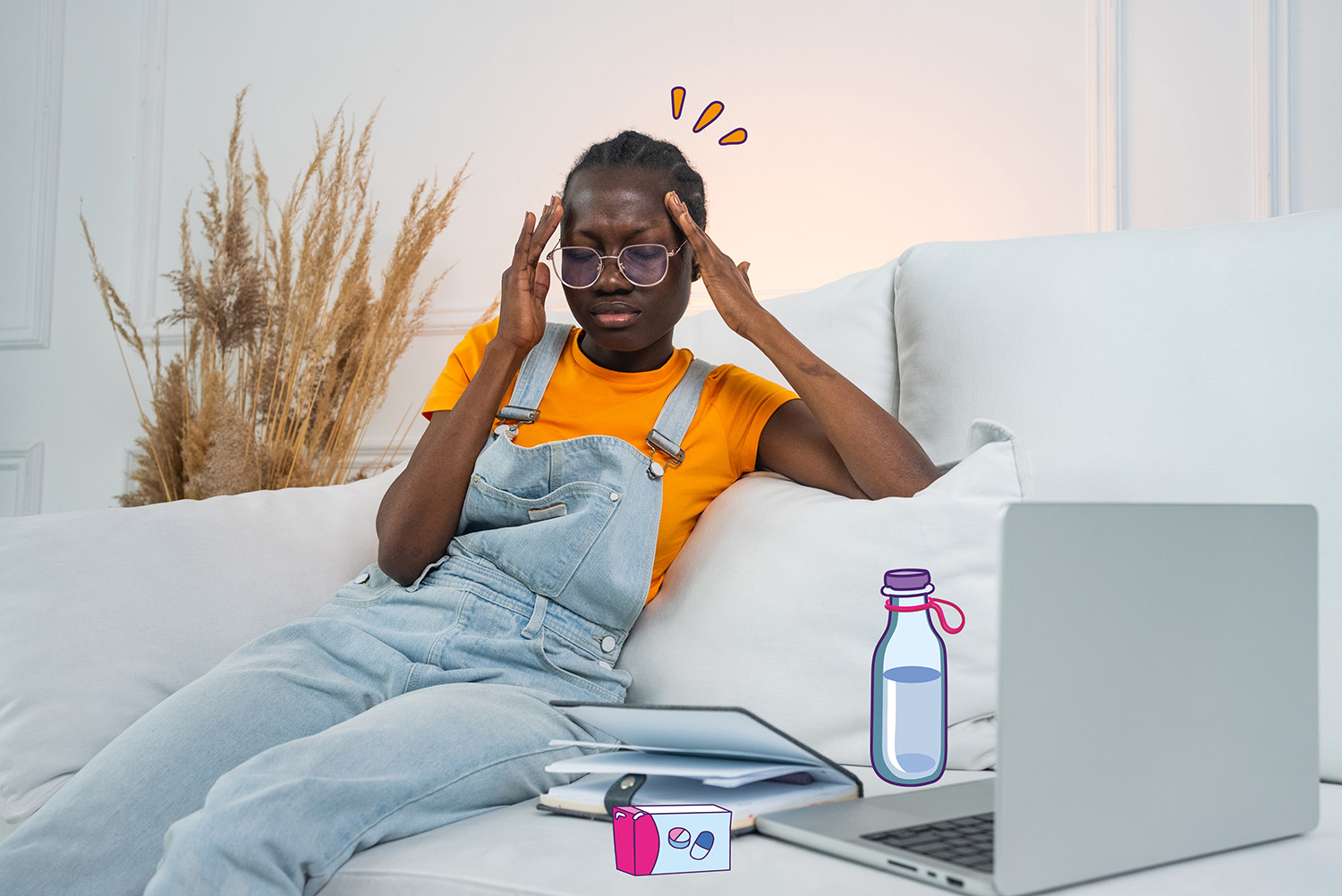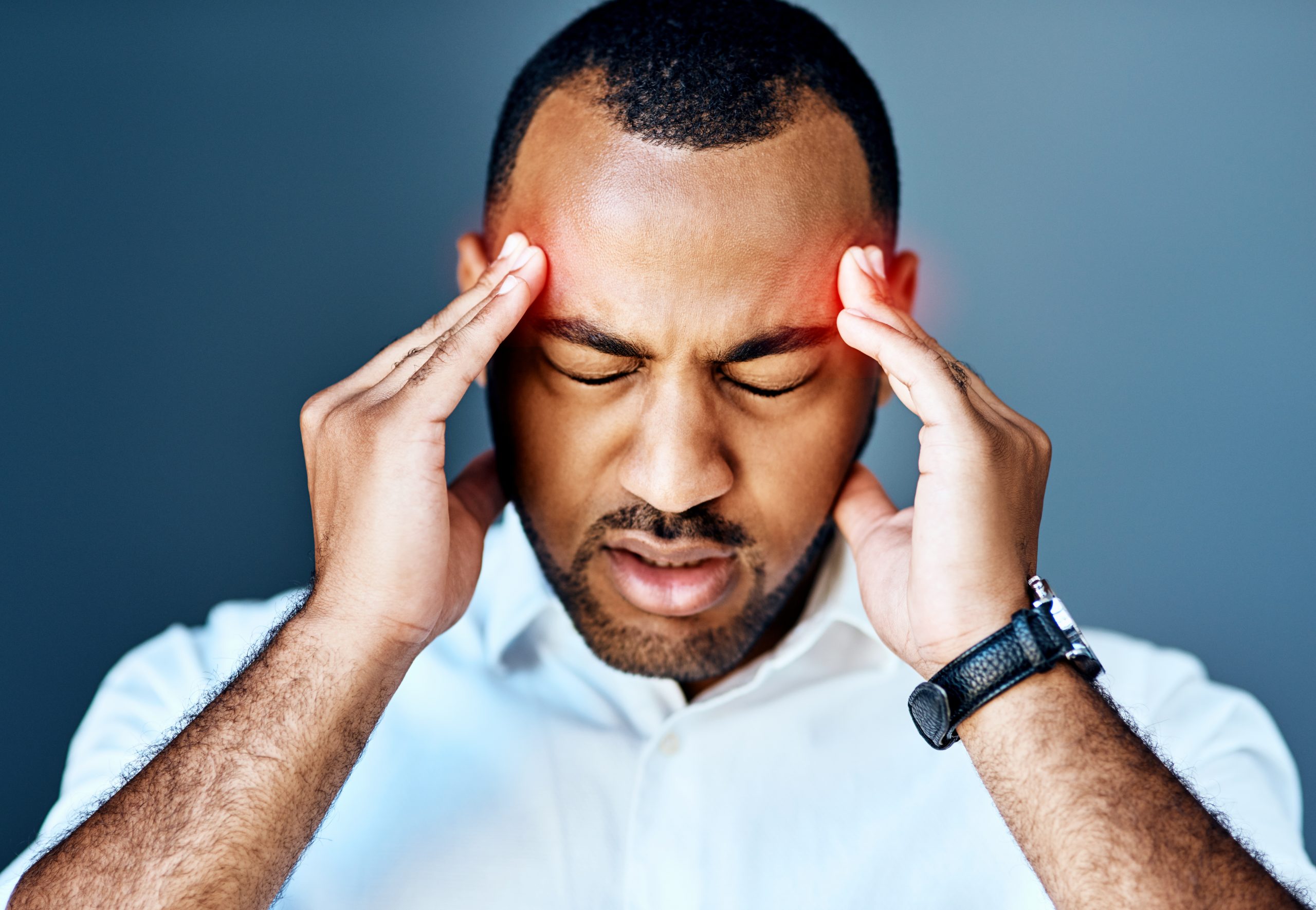Migraine
Explore this health file to better understand migraine: its causes, its symptoms but also the means of prevention and treatment.

Posted on
I. Definition and key figures
Migraine is a chronic disease characterized by painful headaches that appear in the form of repeated attacks [1]. Headaches can be moderate to severe in intensity, often occur on only one side of the head, are recurrent (attacks occur regularly) and feel like a heartbeat in the head (headaches are pulsatile) [1,2].
There are two main types of migraine attacks: migraine attacks without aura and migraine attacks with aura, i.e. accompanied or preceded by temporary neurological disorders (sensory, auditory, visual, etc.) [1].
Migraine is due to abnormal excitability of neurons that is caused by various factors: genetic and environmental. Migraine can have an impact on the quality of life of those who suffer from it [1,2].
Key figures [3]:
- Migraine most often appears during puberty and affects people between 35 and 45 years of age
- It is twice as frequent in women as in men due to hormonal influences
- It is recurrent, often lasts a lifetime and is characterized by recurrent attacks
II. Causes
Migraine is due to an abnormal excitability of neurons, as it is the case for other diseases such as epilepsy [1]. In the case of migraine, this phenomenon can be favored by genetic predispositions and by environmental triggering factors (hormones, stress, food…) [1,2].
Genetic predisposition:
Since the 19th century, it has been recognized that there is a hereditary character to migraine. It seems to be more important for migraines with aura than for migraines without aura [1].
Environmental triggering factors
There are several factors that can encourage or trigger a migraine attack and these vary from one individual to another. Each person has his or her own triggers, which may change over the course of a lifetime. These are essentially [1,2]:
- Emotional variations (stress, frustration…)
- Overwork, relaxation or physical effort more intense than usual
- Excess or lack of sleep
- Hormonal variations, especially during menstruation. In women, the decrease in estrogen levels at the end of the cycle can lead to a so-called catamenial or menstrual migraine
- A change in climate (drop in atmospheric pressure, strong wind, intense cold)
- Exposure to strong or flashing lights
- Exposure to intense smells
- A change in the diet (skipping a meal, eating too much, eating a lot of chocolate, cold meats, tobacco, coffee or alcohol)
III. The symptoms
In most patients with migraine, the attack lasts less than six hours and can be shortened by taking appropriate medication. Nevertheless, in about 15% of patients, the attack lasts more than 24 hours [1].
The frequency of attacks is also quite variable. Some patients will have a few attacks per year and others several per month. Between each attack, the symptoms disappear completely [1].
As a reminder, there are two main types of migraine attacks: migraine attacks without aura and migraine attacks with aura, i.e. accompanied or preceded by temporary neurological disorders [1].
Migraine attacks without aura
In most cases, patients with migraine will have migraine attacks without aura. These manifest as moderate to severe headaches that last from 4 to 72 hours (without treatment or with ineffective treatment) and feel like the heart is beating in the head. Typically, these attacks are accompanied by nausea or even vomiting and/or strong sensitivity to light, noise and smells [1,2].
Migraine attacks without aura have at least two of the following four characteristics:
- They occur on one side of the head only
- The patient feels as if the heart is beating in the head
- The intensity of the pain interferes with the patient’s activities and may require the patient to lie down
- Pain is aggravated by movement and causes avoidance of certain routine activities [1]
Migraine attacks with aura
In 20 to 30% of migraine patients, headaches are preceded or accompanied by an aura, i.e. a temporary neurological disorder that is completely reversible. The auras manifest themselves in the form of visual (90% of cases), sensory, language and/or speech disorders, or even motor disorders. These may include the vision of luminous points, colored spots, holes in the field of vision, distorted perception of objects, but also tingling in the fingers or lips, dizziness or trouble speaking. [1,2].
IV. Prevention
As mentioned above, each person has his or her own triggers and these may change over the course of a lifetime and according to the situation.
Nevertheless, identifying these triggering factors, acting on them and adopting a healthy lifestyle can help reduce migraine attacks [1,4].
This is why it is generally recommended to [1,4] :
- Get regular and sufficient sleep (regular bedtimes and wake-up times)
- Exercise and warm up well before each sport session. Endurance has been proven to be effective in preventing migraine attacks. For example, you can do 2.5 hours of brisk walking, running, biking or any other activity that improves endurance every week
- Quit smoking
- Eat a healthy and balanced diet and do not skip meals
- Avoid drinking alcohol and drink water to stay hydrated
- Reduce the consumption of foods that may trigger your attacks
- Try to relax and avoid stress
- Avoid prolonged exposure to noise or light if these are factors that can trigger your symptoms
If, in spite of these measures, you have a migraine attack, here are some things you can do to reduce its intensity [4]:
- Lie down in a dark and quiet room
- Put a cold or wet cloth on your forehead
- Drink water to avoid dehydration, especially if your migraine is accompanied by vomiting
V. Treatments
There is no permanent cure for migraine. The management of the disease is based on the adoption of a healthy lifestyle and the avoidance of modifiable triggering factors to reduce the frequency of migraines. However, it is possible to treat the attacks and their symptoms and, for some patients, to prevent their occurrence with a daily background treatment [1].
- Crisis treatment is intended to limit the severity and duration of the migraine attack. It should be taken as soon as possible after the onset of the attack. The generally recommended therapeutic classes are non-steroidal anti-inflammatory drugs (NSAIDs) and triptans [1]. Whichever option is chosen, it is important to consult your doctor and not to exceed the prescribed duration of treatment to avoid the risk of migraines due to increased use of medication [1].
- Background treatment is intended to reduce the frequency of attacks. It is prescribed to people who have frequent, intense, long-lasting attacks and/or who consume excessive amounts of crisis treatment. Several drugs belonging to different therapeutic classes are effective, ask your doctor for advice. [1]
Explore our other health files by clicking here.
POI 0851-05/23
Sources :
-
https://www.inserm.fr/dossier/migraine/ – Dossier Migraine – Une maladie de mieux en mieux connue – INSERM
-
https://www.ameli.fr/assure/sante/themes/migraine/symptomes-facteurs-declenchants-evolution#text_6433 – Migraine : symptômes, facteurs déclenchants et évolution – AMELI
-
https://www.who.int/fr/news-room/fact-sheets/detail/headache-disorders – Céphalées – OMS
-
https://www.ameli.fr/assure/sante/themes/migraine/bons-reflexes-cas-faut-consulter – Migraine : que faire et quand consulter ? – AMELI

